Friday
Dharma TeachingsSupplication to the Takpo Kagyu
We continue exploring the Shambhala chants with a look at the Kagyu lineage supplication
by Russell Rodgers
The Kagyu lineage is one of the three main Tibetan lineages that form the basis of Shambhala Buddhism. Each of these lineages contributed a unique approach to enlightenment. The particular approach of the Kagyu lineage is marked by a very methodical progression of practice and study that leads deeper and deeper into their specialty, mahamudra. Shamatha/vipashyana, Kagyu ngondro, Vajrayogini, Chakrasamvara, the mahamudra retreats, and the six yogas of Naropa are all part of the Kagyu mahamudra system.
The Kagyu forefathers are the ones whose stories we are most familiar with. The stories are well documented historically, and colorful as well. Many older students have treasured relationships with Kagyu teachers, including Thrangu Rinpoche, Khandro Rinpoche, His Holiness Karmapa and Khenpo Tsultrim Gyamtso. Trungpa Rinpoche himself was a Kagyu. So this lineage has a major place in our heritage.
Turning to the chant itself, it begins:
Great Vajradhara, Tilo, Naro,
Marpa, Mila, Lord of Dharma Gampopa,
In the Kagyu lineage, devotion is very important. “Devotion” is a translation of the Tibetan word “mo-gu,” which implies longing to experience the guru’s mind, accompanied by a genuinely humble and open quality on the part of the student. Therefore the chant begins by acknowledging the sources of the lineage. Knowing a bit about the stories helps to get a sense of what kind of guru’s mind is at play.
Vajradhara is the source of inspiration. Because we live in a world based on names and concepts, the name “Vajradhara” enables us to point our awareness to the nameless source: the dharmakaya. The dharmakaya is the great space of mind that is empty but has the potential to manifest all experience. At the dharmakaya level, it remains as pure potential. So Vajradhara could be described not as an entity, but as a sort of cosmic buddha-potential that pervades all sentient beings.
Tilo, short for Tilopa, was born in India, and lived from 988-1069 A.D. He had human teachers, but he went beyond his human teachers into the dharmakaya. He was the first human in the Kagyu lineage to enter the dharmakaya and report back, thus starting the Kagyu lineage. At a certain point in Tilopa’s training, his teachers gave him permission to abandon formal meditation and enter into meditation in action. In Tibetan buddhist paintings, he is usually depicted holding a fish. According to Thrangu Rinpoche, as he was wandering about, he noticed that fishermen were catching fish and discarding the entrails. By eating the entrails, he was able to do two things: be free to practice whenever he wanted and also to practice equanimity. Equanimity is the ability to separate the concepts about things from the pure experience, which is beyond good or bad, tasty or disgusting.
For twelve years, Tilopa pounded sesame seeds during the day to obtain their oil. At night he served a village courtesan, escorting male clients in and out of her quarters. In the Indian Buddhist tradition, by putting oneself into lowly jobs, one can eliminate any vestige of arrogance. In this way he practiced the samadhi of suchness.
Tilopa’s student Naro, short for Naropa (1016-1100 A.D.), came from a quite different walk of life. He was a famous and successful professor at Nalanda University. At that time, universities in India were great centres of learning and debate. Each of the four gates to Nalanda had a master scholar in charge. It was that person’s job to debate opposing masters from other schools who wished to challenge the views of the scholars at that university. Naropa was a great success in these debates, and, like many very intelligent people, became proud of himself. This pride was punctured when an old woman asked him if he understood the words of the dharma. When Naropa confidently retorted that he did, the hag was very happy. When she asked if he understood the meaning as well as the words, Naropa again attested confidently that he did. The hag began to cry. She told him in no uncertain terms that he had better seek out the yogi Tilopa if he ever wanted to truly understand the dharma.
Tilopa was not easy to find, and Naropa’s arrogance prevented him from recognizing Tilopa several times when he did encounter him. However, Naropa had intense longing for someone who could show him enlightened mind, and he finally succeeded. Tilopa put him through rigorous trials in order to break through his residual arrogance and suppositions about reality.
Naropa’s student Marpa (1012-1097) was the first Tibetan in the lineage. Marpa had been angry and aggressive as a child. His parents, thinking that he would likely become a brigand unless something was done, sent him to a monastery. When he grew up, Marpa went to India, looking for teachings that he could bring back to Tibet. He made three trips to India, studying with Naropa and others. At first, he just wanted to collect teachings without really understanding them. When he lost his books in a river on the way back to Tibet, he finally realized that the only teachings that mattered were the ones that he understood. On one of his trips, he presented the customary offering of gold dust to Naropa, who casually threw it into the jungle. Striking his big toe on the ground, rocks and pebbles became gold. Naropa said, “Everything is a land of gold.”
Marpa’s student Mila, short for Milarepa (1040-1123), had been involved in a family feud and killed several people. He was an earnest person and he had a very guilty conscience. By that time Marpa had understood the energy of anger in its enlightened form, so he used his anger to cut through Milarepa’s assumption that by dutifully being a “good” student, he could receive Marpa’s transmission. Milarepa was at that point not genuinely open, so Marpa made him build a four story stone tower and then tear it down and start over. He did this four times. Each time he directed his anger at Milarepa and accused him of not following instructions. Finally, Milarepa dropped his façade of earnestness and was genuinely open to Marpa’s mind. Subsequently, Milarepa meditated in caves throughout Tibet, and ripened Marpa’s instruction to the point where he became Tibet’s most famous yogi-saint. His extemporaneous songs and verses expressed his realization and are still important teaching tools today.
Gampopa (1079-1153) was a physician-monk from Takpo, who, upon merely hearing of Milarepa, was filled with great longing and the need to find him. Gampopa brought a monastic element into the Kagyu lineage, which up to this point had been composed of wandering yogis.
Knower of the Three Times, omniscient Karmapa,
Holders of the four great and eight lesser lineages—
Drikung, Tag-lung, Tsalpa, these three, glorious Drukpa and so on—
Masters of the profound path of mahamudra,
Incomparable protectors of beings, the Takpo Kagyu,
I supplicate you, the Kagyu gurus.
I hold your lineage, grant your blessing so that I will follow your example.
Four great and eight lesser Kagyu schools evolved from Milarepa’s students. The Karma Kagyu descended from Gampopa. Since Gampopa was known as “The Physician from Takpo”, the Karma Kagyu are also known as the Takpo Kagyu: hence the name of this chant, Supplication to the Takpo Kagyu.
One of Gampopa’s students was the first Karmapa, Tusum Kyenpa. In the tulku tradition that Tusum Kyenpa initiated, when the abbot of a monastery dies, he reincarnates as a tulku, is recognized, and then trained to be the next abbot. Accomplished students of the previous abbot train the young tulku, so that there can be an unbroken line of transmission. The Kagyu tradition holds that a living human connection is essential to transmit the essence of the lineage wisdom.
Revulsion is the foot of meditation, as is taught.
To this meditator who is not attached to food and wealth,
Who cuts the ties to this life,
Grant your blessings so that I have no desire for honor and gain.
Before one can be effective in the world, one has to move beyond attachment. One path is the actual abandonment of people or things that one is attached to. A more subtle path involves maintaining a connection, but abandoning the attachment. As meditators become more experienced, they begin to see their thought patterns and how those patterns create suffering. A sense of revulsion arises towards those patterns. One of the most fundamental kinds of renunciation is to abandon attachment to one’s own thoughts. Only then can one appreciate them as the energetic play of the mind.
Devotion is the head of meditation, as is taught.
The guru opens the gate to the treasury of oral instructions.
To this meditator who continually supplicates him
Grant your blessings so that genuine devotion is born in me.
Devotion, or mo-gu, means “longing and respect.” At its crudest level, devotion can be hero worship of the guru as a person–a kind of personality cult. Perhaps one wants an all-knowing advisor who will help one select a career or solve marriage problems. Maybe one wants to simply improve one’s social status by having close proximity to the teacher and then have stories to tell. This kind of primitive devotion does have some useful aspects, but the true meaning of devotion goes deeper. It is longing to experience the world as the guru does. True devotion also has a strong element of respect, based on one’s own personal experience of the mind of the guru and the mind of the lineage that he or she represents.
The mind of the guru can be found in the atmosphere of the room he/she is in, in the teachings, and in the teaching mandala that he/she has created to communicate that mind. Trungpa Rinpoche and Sakyong Mipham Rinpoche, for instance, have placed tremendous emphasis on how the shrine room is set up and the quality of wakefulness that communicates. The appointment of acharyas as traveling teachers is just another small example of how a guru can create a mandala to transmit the sense as well as the words of the teachings.
Awareness is the body of meditation, as is taught.
Whatever arises is fresh—the essence of realization.
To this meditator who rests simply without altering it,
Grant your blessings so that my meditation is free from conception.
Many meditators think that meditation is a thoughtless, blank, peaceful state. In fact, this is a often kind of ignorance–dwelling in subtle thoughts, like the thought of meditation. Some thoughts can be so subtle that they are hard to detect. Instead of dwelling in a peaceful, blank state, we are asked to notice the quality of freshness—which is related to wakeful mind. When one rests in pure wakefulness, thoughts can come and go, and there is no need to alter anything. Freshness remains in the midst of thoughts. In the beginning, though, it is necessary to rely heavily on mindfulness of the breath, or one will simply become carried away by the stream of discursiveness.
The essence of thoughts is dharmakaya, as is taught.
Nothing whatever, but everything arises from it.
To this meditator who arises in unceasing play
Grant your blessings so that I realize the inseparability of samsara and nirvana.
If one rests in fresh awareness, without attachment to conceptualization, then one can appreciate thoughts as the play of the mind. They come out of the great empty space of mind called dharmakaya, and they retain the qualities of dharmakaya as their essential nature. They are empty and transparent, but still part of the present display. In this way thoughts become an opportunity for experiencing the dharmakaya. The meditator sees them as inherently empty, but still appreciates the vividness and dance of their energy. Their vividness and energy is the discovery of luminosity. That is how nirvana (the peace of liberation) is realized in the very midst of samsara (the entrapment of thoughts and projections).
Through all my births may I not be separated from the perfect guru
And so enjoy the splendor of dharma.
Perfecting the virtues of the paths and bhumis,
May I speedily attain the state of Vajradhara.
The Buddhist journey is commonly divided into five paths, or stages of development: the paths of accumulation, unification, seeing, meditation, and no- more-learning. These overlap with an alternate classification called the ten bhumis. Each bhumi is a stage in the approach to buddhahood. For example, the first bhumi is called Supreme Joy, because one experiences true emptiness for the first time, and is freed from fear of all kinds. The joy experienced here is far deeper and more permanent than the transient joy experienced by ordinary people. The major practice here is transcendental generosity. Attaining the state of Vajradhara is equivalent to buddhahood, the final stage after the 10th bhumi.
The perfect guru is the perfect spokesperson for reality. If we have a strong karmic connection with a guru, then it is likely that we will have a relationship with him or her in the future, and so enjoy the splendor of dharma.
 Russell Rodgers has been wondering about this kind of topic for the 39 years that he has been practicing. He resides in the Kootenay mountains of British Columbia, in the town of Nelson, and has graciously agreed to allow publication of his beautiful essays on the Shambhala chants here in the Times.
Russell Rodgers has been wondering about this kind of topic for the 39 years that he has been practicing. He resides in the Kootenay mountains of British Columbia, in the town of Nelson, and has graciously agreed to allow publication of his beautiful essays on the Shambhala chants here in the Times.

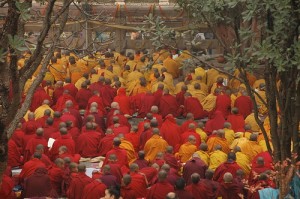

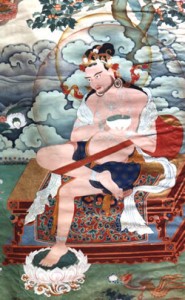
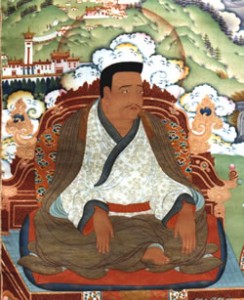
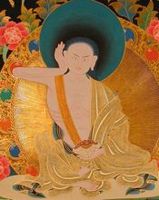
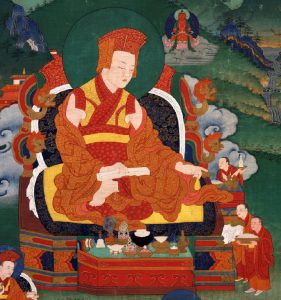
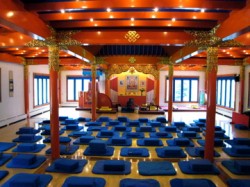




Oct 27, 2016
Reply
Editor’s note: the author is describing the three main lineages that form the basis of Shambhala Buddhism specifically, rather than listing the schools of Tibetan Buddhism overall.
Oct 26, 2016
Reply
Traditionally there are 4 schools of Tibetan Buddhism: Nyingma, Kagyu, Sakya and Gelug. The Jonang, an offshoot of the Sakya, can be considered a fifth. Although Jonang was officially banned in the 1650s, it is still around. The Dalai Lama has also been speaking of the Bon as another school.
I’m curious why you said there are only three schools.